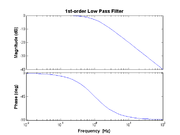Difference between revisions of "Bode plots and frequency response"
Eliot Frank (Talk | contribs) (Created page with "A Bode plot is a log-log representation plot of the magnitude of a transfer function versus frequency. In a Bode plot, only straight line segments are used to approximate the tr...") |
|||
| Line 1: | Line 1: | ||
| + | {{Template:20.309}} | ||
| + | ==Overview== | ||
| + | Only two things can happen to a sine wave passing through a linear, time-invariant system: it's magnitude can be changed; and the signal can be delayed. The delay and percentage change in the magnitude are a function of frequency. A '''transfer function''', ''H(f)'', is a complex-valued function of frequency that specifies the magnitude and phase shift of a particular system for all frequencies. The change in amplitude is often called the gain, and the delay is usually thought of in terms of a phase shift of the sine wave. | ||
| + | |||
| + | One way to visualize a transfer function is to make two plots. The first plot shows the gain verses frequency on a set of log-log axes. The second plot shows the phase shift versus log frequency. | ||
| + | |||
A Bode plot is a log-log representation plot of the magnitude of a transfer function versus frequency. In a Bode plot, only straight line segments are used to approximate the transfer function. At a critical or cutoff frequency, there is an abrupt change in slope in the transfer function instead of a smooth transition (e.g., from pass band to stop band). | A Bode plot is a log-log representation plot of the magnitude of a transfer function versus frequency. In a Bode plot, only straight line segments are used to approximate the transfer function. At a critical or cutoff frequency, there is an abrupt change in slope in the transfer function instead of a smooth transition (e.g., from pass band to stop band). | ||
| Line 28: | Line 34: | ||
: <math> H(f) = \frac{j f / f_{\rm HP}}{1 + j f / f_{\rm HP}} | : <math> H(f) = \frac{j f / f_{\rm HP}}{1 + j f / f_{\rm HP}} | ||
\times \frac{1}{1 + j f / f_{\rm LP}} </math> | \times \frac{1}{1 + j f / f_{\rm LP}} </math> | ||
| + | |||
| + | {{Template:20.309 bottom}} | ||
Revision as of 17:03, 27 March 2013
Overview
Only two things can happen to a sine wave passing through a linear, time-invariant system: it's magnitude can be changed; and the signal can be delayed. The delay and percentage change in the magnitude are a function of frequency. A transfer function, H(f), is a complex-valued function of frequency that specifies the magnitude and phase shift of a particular system for all frequencies. The change in amplitude is often called the gain, and the delay is usually thought of in terms of a phase shift of the sine wave.
One way to visualize a transfer function is to make two plots. The first plot shows the gain verses frequency on a set of log-log axes. The second plot shows the phase shift versus log frequency.
A Bode plot is a log-log representation plot of the magnitude of a transfer function versus frequency. In a Bode plot, only straight line segments are used to approximate the transfer function. At a critical or cutoff frequency, there is an abrupt change in slope in the transfer function instead of a smooth transition (e.g., from pass band to stop band).
For example, consider a simple RC low-pass filter with the transfer function is given by
- $ H(f) = \frac{V_{out}}{V_{in}} = \frac{1}{1 + j2\pi f RC} $
In this case the cutoff frequency is given by $ f_C = 1/(2\pi RC) $. In the Bode plot of this function, a straight line segment with zero slope for $ f < f_C $ represents the pass band of the filter while a line with a slope of −1 for $ f > f_C $ represents the stop band.
More examples
High-pass
- $ H(f) = \frac{j2\pi f \tau_{\rm HP}}{1 + j2\pi f \tau_{\rm HP}} $
- $ H(f) = \frac{j f / f_{\rm HP}}{1 + j f / f_{\rm HP}} $
Second-order low-pass
- $ H(f) = \left(\frac{1}{1 + j2\pi f \tau_{\rm LP}}\right)^2 $
- $ H(f) = \left(\frac{1}{1 + j f / f_{\rm LP}}\right)^2 $
Band pass
- $ H(f) = \frac{j2\pi f \tau_{\rm HP}}{1 + j2\pi f \tau_{\rm HP}} \times \frac{1}{1 + j2\pi f \tau_{\rm LP}} $
- $ H(f) = \frac{j f / f_{\rm HP}}{1 + j f / f_{\rm HP}} \times \frac{1}{1 + j f / f_{\rm LP}} $


